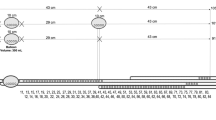Abstract
We examined the interaction between the sacral neural system and the anorectal activity using a technique comprising repetitive magnetic stimulation. Thirteen control children without any bowel dysmotility (age range; 3 month old to 15 year old), 20 patients with chronic constipation (1 month old to 14 year old), and nine pre-operative patients with Hirschsprung’s disease (1 month old to 6 year old) were examined. Magnetic stimulation was applied at the S3 level using the MagPro (Medtronic) device while simultaneously performing manometric recordings of the anorectal activity. In the 13 controls and the 20 patients with chronic constipation, the rectoanal reflex was demonstrated by balloon rectal dilatation. The sphincter response to magnetic stimulation was biphasic in the controls, consisting of an initial rise followed by a decrease in the sphincter pressure, while it varied among the patients with chronic constipation including a biphasic response in 16 patients, no response in three patients, and only a transient rise in pressure in one patient. In nine pre-operative patients with Hirschsprung’s disease, no rectoanal reflex was observed, however, the sphincter pressure increased due to magnetic stimulation in six patients, while three patients exhibited no recordable responses. These results suggest that the repetitive magnetic stimulation technique is a valuable modality for investigating the neural interaction between the sacral nervous system and the anorectum.

Similar content being viewed by others
References
Marte A, Cotrufo AM, Di Iorio G et al (2001) Electromyographic and manometric anorectal evaluation in children affected by neuropathic bladder secondary to myelomeningocele. Minerva Pediatr 53:171–176
Morera C, Nurko S (2003) Rectal manometry in patients with isolated sacral agenesis. J Pediatr Gastroenterol Nutr 37:47–52
Tjandra JJ, Ooi BS, Han WR (2000) Anorectal physiologic testing for bowel dysfunction in patients with spinal cord lesions. Dos Colon Rectum 43:927–931
Correa GI, Rotter KP (2000) Clinical evaluation and management of neurogenic bowel after spinal cord injury. Spinal Cord 38:301–308
Fujishiro T, Takahashi S, Enomoto H et al (2002) Magnetic stimulation of the sacral roots for the treatment of urinary frequency and urge incontinence: an investigational study and placebo controlled trial. J Urol 168:1036–1039
Chiarelli P, Murphy B, Cockburn J (2003) Fecal incontinence after high-risk delivery. Obstet Gynecol:1299–1305
Matzel KE, Stadelmaier U, Hohenfellner U et al (1995) Electrical stimulation of sacral spinal nerves for treatment of faecal incontinence. Lancet 346:1124–1127
Vaizey CJ, Kamm MA, Turner IC et al (1999) Effects of short tem sacral nerve stimulation on anal and rectal function in patients with anal incontinence. Gut 44:407–412
Kubota M, Suita S (2002) Assessment of the sphincter muscle function before and after posterior sagittal anorectoplasty using a magnetic spinal stimulation technique. J Pediatr Surg 37:617–622
Fasth S, Hulten L, Nordgren S (1980) Evidence for a dual pelvic nerve influence on large bowel motility in the cat. J Physiol (Lond) 298:159–169
Maccabee PJ, Lipitz ME, Desudchit T, et al (1996) A new method using neuromagnetic stimulation to measure conduction time within the cauda equina. Electroencephalogr Clin Neurophysiol 101:153–66
Shafik A, El-Sibai O (2000) Effect of magnetic stimulation on the contractile activity of the rectum in humans. Am Surg 66:491–494
Kubota M, Suita S, Szurszewski JH (1998) Membrane properties and the neuro-effector transmission of smooth muscle cells in the canine internal anal sphincter. J Smooth Muscle Res 34:173–184
Kubota M, Suita S, Kamimura T (1997) Abnormalities in visceral evoked potentials from the anal canal in children with chronic constipation. Surg Today 27:632–637
Emir H, Akman M, Sarimurat N et al (1999) Anorectal manometry during the neonatal period: its specificity in the diagnosis of Hirschsprung’s disease. Eur J Pediatr Surg 9:101–103
Acknowledgments
The authors thank Mr. Brian Quinn for his critical reading of the manuscript. Grant Support: Grant-in-aid for Scientific Research (B) (No.14370566) from the Japan Society for the Promotion of Science.
Author information
Authors and Affiliations
Corresponding author
Rights and permissions
About this article
Cite this article
Kubota, M., Okuyama, N., Hirayama, Y. et al. Effect of sacral magnetic stimulation on the anorectal manometric activity: a new modality for examining sacro-rectoanal interaction. Pediatr Surg Int 23, 741–745 (2007). https://doi.org/10.1007/s00383-007-1963-1
Accepted:
Published:
Issue Date:
DOI: https://doi.org/10.1007/s00383-007-1963-1




